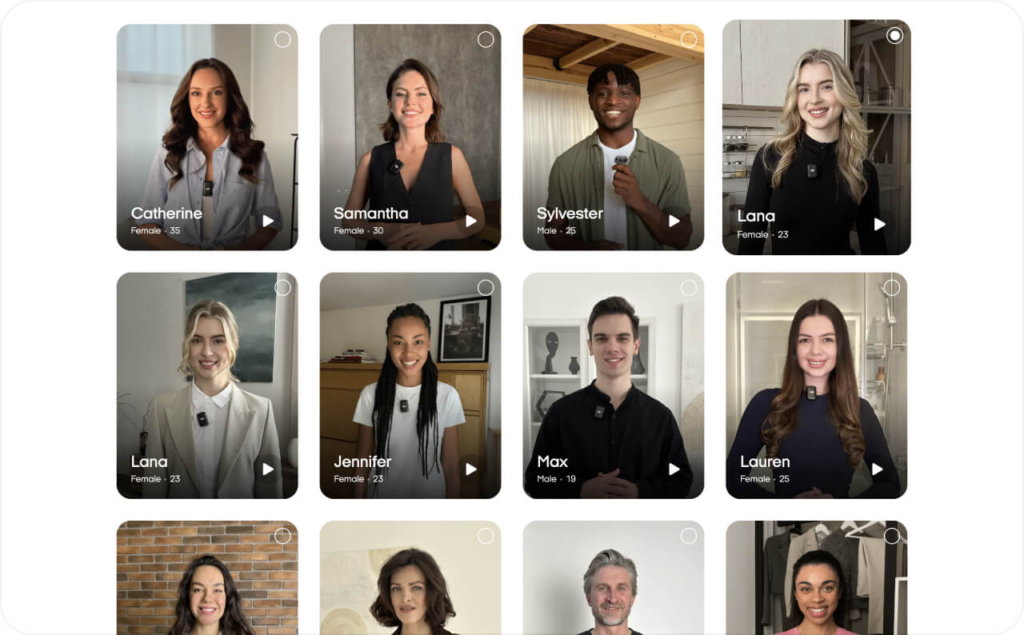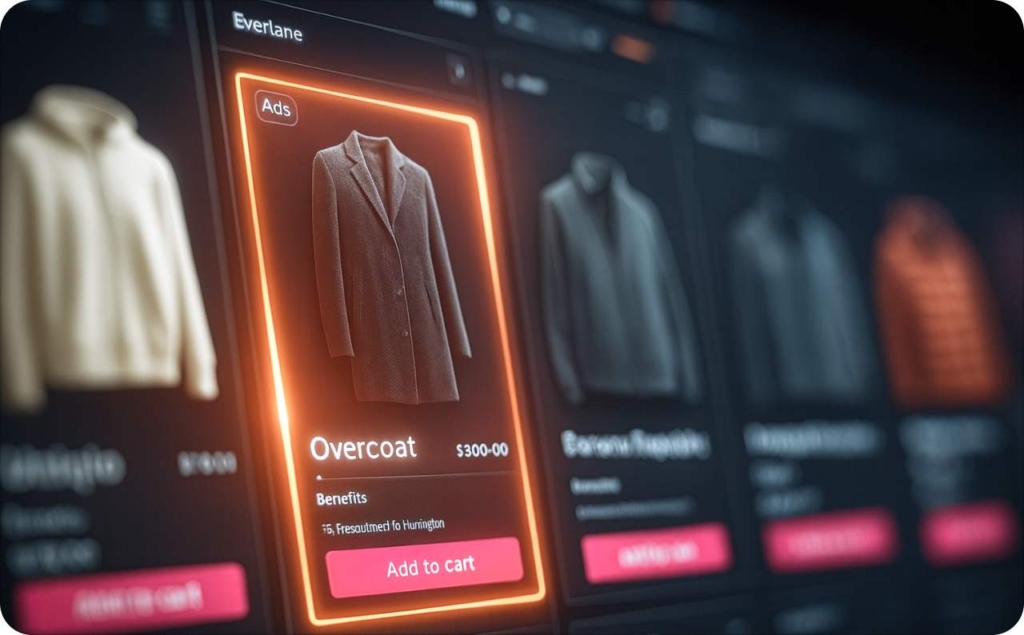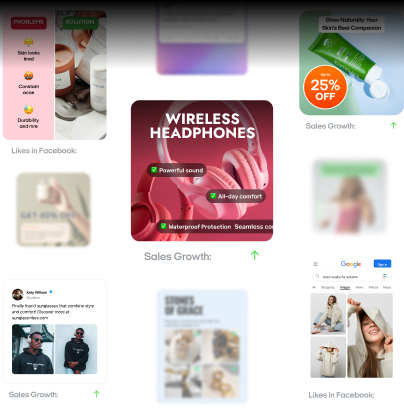Native ads vs. Display ads: 6 crucial factors for better ROI
What’s smarter for your next campaign seamless native or bold display? Zeely AI’s expert analysis uncovers six factors proven to lift ROI and optimize ad spend.
Using the same ad format for every campaign can waste your budget and lower your click-through rates. People today ignore most advertising — especially on mobile. Pop-ups and banner ads no longer grab attention the way they once did, thanks to banner blindness.
According to Statista, digital ad spending jumped over 13% in 2024. But more ad spend doesn’t guarantee better performance if you’re using the wrong format.
In this guide, you’ll see which type of ads — native ads or display ads — fits your goals for brand awareness, retargeting, or higher ROI. You’ll learn how each approach affects user experience on platforms like Google Display.
You’ll also discover how programmatic advertising ties in, and why some ads feel natural while others simply annoy. By the end, you’ll know how to avoid wasted impressions and turn more viewers into conversions.

What are native ads?
You’ve likely seen native ads without realizing they were ads. They fit into your feed or page so smoothly that they feel like regular content.
These ads don’t scream for attention with flashy banners. Instead, they match the style and flow of the platform, making them easier to trust and engage with.
Definition & key characteristics
Native advertising is a paid format where your message blends with the surrounding content. You’ll often see these ads labeled “sponsored” or “promoted”, but they look and feel natural, like an article on a news site or a post on social media.
This approach works well because it meets people where they already are. Instead of interrupting, it offers something relevant and interesting.
Studies show native ads can boost engagement and click-through rates. They thrive in a mobile-first world, where users scroll quickly and ignore anything that feels forced.
Brands are betting big on this format. In 2024, eMarketer projected $80.39 billion in spending for native ads on social platforms.
That’s nearly triple the investment in nonsocial native placements. It shows brands trust these in-feed experiences, where users already expect to see content that’s part of their day-to-day scrolling.
Common formats of native ads
You’ll find native ads appearing in different ways. The goal is always to match each platform’s look and feel, so you don’t disrupt your audience.
In-feed ads show up in social media streams. Sponsored content appears as long-form articles or videos on editorial sites. Content recommendation widgets rest under blog posts and nudge curious readers toward related products or stories.
Promoted listings blend in with search or product results on platforms like Etsy or Amazon. Custom native integrations involve creating quizzes, guides, or interactive modules in partnership with publishers.
Why they perform well
Native ads align with natural browsing habits. They fit in, so they don’t annoy or distract.
By focusing on storytelling rather than hard selling, native ads build trust and spark real interest. When you earn a user’s attention this way, you’re more likely to see higher conversion rates and longer view times.
Compared to traditional display ads, native formats let you become part of the experience. That makes them a smart choice if you want to engage users without shouting for attention.

What are display ads?
Display ads are a cornerstone of digital advertising. They’ve evolved from simple banners into bold, eye-catching formats designed to stand out.
Unlike native ads, which blend into surrounding content, display ads aim to grab attention fast. They use color, animation, or strategic placement to spark immediate interest.
If your ads feel irrelevant or untimely, your audience may ignore them. That issue is known as ad fatigue, and it’s why some marketers doubt if display ads still work.
They can still work — if you focus on smart targeting and strong visuals. When you align your creative with user intent, display ads become a powerful way to reach people on websites and mobile apps.
Definition & key features
Display ads are visual promotions that show up on platforms like the Google Display Network. They include banner ads, pop-ups, or full-screen takeovers that appear while people browse.
Their goal is to disrupt the flow in a strategic way. You can feature bold headlines or animations to catch the eye, pushing a brand awareness campaign or driving direct conversions.
Google reports an average CTR of around 0.35% for these ads, but clicks aren’t the whole story. Research shows users are 155% more likely to search for your brand-specific terms after seeing a display ad, which can boost long-term brand recall.
Retargeting & timing
Retargeting is a major draw for display. If someone visits your site but doesn’t convert, you can show them relevant ads elsewhere, nudging them back.
Remember to respect user experience. Pop-ups and autoplay videos can annoy people if triggered too often, especially on mobile where screen space is limited.
If your goal is visibility, recapturing lost traffic, or growing brand recognition, display ads help you stay top-of-mind. Just balance relevance, device context, and timing so you don’t push users into ad fatigue.
Common formats of display ads
Banner ads appear at the top, bottom, or sides of a page. They’re easy to spot and work well for brand awareness when paired with bold visuals.
Interstitial ads fill the entire screen between articles or app transitions. They grab attention fast but might frustrate users if they pop up too often.
Animated and clickable ads use GIFs or interactive elements to stand out in busy feeds. They can boost engagement when you need to capture attention quickly.
Pop-up ads show up based on triggers like exit intent. They can collect leads or highlight special offers right before someone leaves your site.
Retargeting ads follow users who’ve already interacted with your brand. They appear on different sites and remind people what they browsed or left in their carts.
Each format offers visibility and measurable performance. With the right approach, display ads can spark brand lift, boost conversions, and keep your business at the forefront of customers’ minds.
Key differences between native ads and display advertising
Native ads blend into content, while display ads stand out. That difference shapes everything from user trust to retargeting tactics.
Integration vs. Disruption
If your ads feel annoying, people ignore them. Native ads focus on seamless integration by appearing in social feeds or recommended articles.
This cuts down on banner blindness, which impacts 86% of users. Display ads, on the other hand, rely on pop-ups and banners to grab attention fast.
They’re great for flash sales or time-sensitive deals. But repeated exposure can lead to ad fatigue — especially on mobile, where screens are small and patience is thin.
Use native to build trust. Use display when you need bold, immediate reach.
Engagement & interaction metrics
Not all ad views trigger action. Native ads often see higher click-through rates because they blend in with page content.
They can drive up more engagement than standard banners. People spend longer on these ads, explore deeper links, and trust the message more.
Display ads excel at retargeting and brand recall. Even if viewers don’t click right away, repeated exposure sticks in their memory.
On networks like the Google Display Network, you can track CPC, CPM, and conversions precisely. That data helps you optimize ROI.
If you’re after deeper engagement, native often wins. If you want repeated touchpoints, display might be your best friend.
Ad format flexibility & visual impact
Your creative approach shapes how people react. Native ads thrive on contextual relevance, like in-feed stories or sponsored content that match the site’s tone.
They’re subtle and help you foster long-term trust. Display ads allow more visual freedom — you can run static banners, animated designs, or interactive elements.
Brands can also test copy, visuals, and calls to action in real time using tools like Google Ads, Zeely AI, or DCO software. That’s perfect for A/B tests and dynamic video ads campaigns.
Keep in mind that flashy ads on a calm editorial page can backfire. Align your visual storytelling with user expectations, and watch out for mobile performance.

Final takeaway
Use native ads early in the funnel to educate and build trust. Switch to display ads when you need reach or a bolder push for conversions.
Mix both across channels to guide your audience from that first impression to the final sale — without pushing them away.
ROI & performance metrics: Native ads vs. Display ads
If you measure only clicks, you might miss the real ROI. It’s easy to think an ad works just because it grabs attention. But your business needs the full story to see which interactions lead to revenue.
Comparative analysis of ROI
Native ads often excel in longer campaigns. They blend with content, so people spend more time engaging and trusting your message.
A study found native can lower cost-per-action by 32% compared to display ads. That suggests stronger conversion quality over time, especially for brand storytelling or content-rich funnels.
But native takes patience. If you’re looking for quick hits or flash promos, AI display ads might work better.
Display ads focus on speed. You can run banners or pop-ups to drive traffic fast, testing cost-per-click in real time.
Cheap clicks don’t always mean high conversion. If targeting or creative is off, you might end up paying for visitors who never convert.
For example, a native ad may guide someone to a blog post, then they return later to buy. A display retargeting ad could nudge a cart abandoner into an immediate purchase.
Use analytics tools to track CPC, CTR, CPA, and conversion rates. If you want long-term trust, native often leads. If you need fast conversions, the display might deliver — but be ready to optimize often.
Measuring campaign success and attribution
Attribution modeling shows which ads or touchpoints close the sale. It reveals if native or display truly contributes to your bottom line.
Go beyond the click. Tools like Google Analytics, Meta Ads Manager, or HubSpot show if visitors buy or leave.
Look at scroll depth — how far people read — and session recordings — how they actually behave. These insights help you see friction points in your funnel.
Then pick the right attribution model. First-touch reveals which ad introduced your brand. Last-click spotlights the ad that sealed the deal. Multi-touch shows how native ads build trust early while display ads might finalize conversions.
Don’t let data fool you. Pair quantitative metrics, like CPC, CPA, and conversion rates, with qualitative insights, like heatmaps or surveys. That way, you learn why people act or walk away.
Next steps: Funnel insights & benchmarks
Each metric suits a different stage of the funnel. CPC and CTR matter early. CPA and conversion rates matter late. In the middle, watch engagement to gauge interest.
Compare your numbers with industry benchmarks from places like the Meta Ads library. Then refine your ad mix by investing more where you see profitable results.
That’s how you shift from guessing to growing — by tracking the right data at the right time and mixing native and display to guide users from discovery to conversion.
Conclusion & strategic recommendations
If you’re still torn between native ads and display ads, you actually need both. Savvy marketers mix them to create a holistic, scalable strategy.
You’ll start with native advertising to educate, inspire, and build trust. It shines in awareness and consideration stages, where brand storytelling and subtle engagement matter.
Picture a D2C skincare brand running native content about ingredient benefits. Readers learn, grow curious, and come back later — ready to buy.
That’s when display ads step in. Use retargeting or flash deals at the decision stage. A banner or pop-up offering a short-term discount can prompt those same fans to complete their purchase.
Think of it as an integrated approach. Don’t run disconnected campaigns. Guide users from first click to final purchase in one journey.
Here’s an example. Run a native ad that links to a product quiz or educational blog post. Then serve a display ad to those who engaged, offering a discount on the exact item they viewed.
Track both native and display with dashboards and attribution models. Measure CPC and CTR early in the funnel. Focus on CPA and conversion rates later, when you want to see real sales impact.
If you’re running ads across Google, Meta, or programmatic channels, sync your messaging. Keep copy, creative strategies, and audience rules consistent so people recognize your brand everywhere.
Native earns attention. Display seals the deal. Blend them to turn casual viewers into loyal customers — and refine your efforts continually for real growth.
Here’s a final recap. Use native ads to spark interest and build trust. Use display ads to retarget and convert. Stay consistent across platforms, track the data, and scale what works. That’s how you move from clicks to loyal customers.
Also recommended



